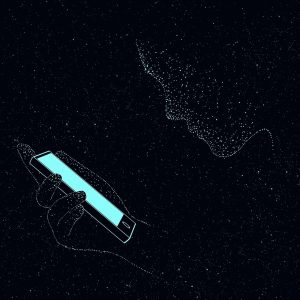The smartphone revolution: exploring the impact of mobile devices on communication and personal identity.
Diana Ortega Molina
In 2007 we witnessed a transformative moment in the history of communication with the introduction of the iPhone. This groundbreaking device seamlessly combined the functions of a phone, a music player, and an Internet communication tool into one sleek package.
Beyond its practical applications, the iPhone has had a profound influence on computer-mediated communication (CMC). Emoticons, GIFs, and memes have emerged as influential tools, enriching digital conversations with visual and expressive elements that transcend traditional text-based communication. These new forms of expression have become part of our digital conversations, allowing us to convey emotions, humour, and cultural references with ease.
Take, for instance, the “Face with Tears of Joy” emoji which was named Word of the Year in 2015 by Oxford Dictionaries (Oh 2015). These symbols, now widely recognised, serve as a means to communicate emotions and expressions that are typically conveyed through facial expressions and body language in in-person conversations (Dresner & Herring 2010).
Mobile apps like Instagram and TikTok, which reach billions of users daily (Dixon 2023) have played a pivotal role in the rise of online personas. Social media channels have given people the tools to curate their online identities meticulously, resulting in the development of online personas (see Chapter 6).
Whether it’s a conscious or subconscious effort, we craft digital identities on platforms that align with our desired self-image. This process involves selecting the most flattering photos, sharing specific aspects of our lives, and even using filters and editing tools to enhance our online presence. In this digital age, our online personas have become a part of how we present ourselves to the world, shaping the way others perceive us and how we perceive ourselves.

Image by 愚木混株 Cdd20 from Pixabay
The rise of smart devices has also facilitated our ability to connect with individuals who share similar interests, values, and experiences. This ability to find and engage with like-minded individuals has given rise to niche communities and subcultures that might not have otherwise existed. As described by Brabham (2013), crowdsourcing is a collaborative process in which individuals contribute their knowledge, skills, and resources to achieve a common goal. Crowdsourcing has found applications in various fields, from science and innovation to social activism and humanitarian efforts. Mobile devices have only made it easier for individuals worldwide to participate in crowdsourcing efforts, contributing their individual knowledge and resources.
Platforms like Reddit, Discord, and GitHub have emerged as central hubs for collaborative efforts, providing spaces for the exchange of ideas, resources, and real-time feedback. Take for example The GameStop stock surge a unique event in which the stock price of the video game retailer GameStop suddenly skyrocketed in early 2021 (Jones, 2021). This surge was primarily driven by individual investors from a Reddit forum called WallStreetBets, who organised to buy GameStop stock and drive up its price, causing large losses for some big hedge funds that had bet against the stock. This event which was facilitated by computer-mediated communications can be considered a symbol of collective intelligence and decentralised decision-making.
Mobile devices have also revolutionised the way we access and consume information. News and information are no longer limited to traditional media outlets but are now readily available through mobile apps, podcasts, social media, and online platforms. This democratisation of information has given individuals the power to be active participants in shaping public discourse, challenging traditional gatekeepers of information, and amplifying diverse voices and unique perspectives.
For example, the Black Lives Matter (BLM) movement, which began as a hashtag on X (formerly known as Twitter), has evolved into a global phenomenon known around the world, pushing forward conversations of racial injustice and systematic racism. Since the inception of the BLM movement, numerous other examples of computer-mediated communications have helped change public discourse by driving social change and putting the audience in the driver’s seat of meaning-making processes.
Mobile devices have undeniably exerted a profound influence on the realms of communication and personal identity. They have not only enhanced the quality of digital interactions but have also played a pivotal role in crafting our online personas and facilitated collaborative endeavours. In today’s world, smartphones have evolved into indispensable instruments, granting us instant connections to people and information that we’ve never previously had access to. This accessibility has ushered in fresh opportunities across various domains such as business, education, and personal development. As a result, individuals and communities now possess the capacity to transcend geographical constraints, forging connections on a scale that was once unimaginable.
About the author
Ahead in Chapter 2…

